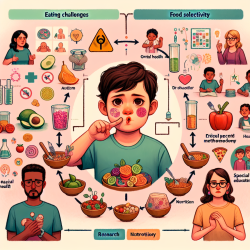In the field of speech-language pathology, evidence-based practice is crucial for delivering effective therapy. One pivotal research article, "The Necessity for Speech Therapy among Children" by Heimann and O'Driscoll (1946), provides invaluable insights that can help practitioners refine their skills and improve outcomes for children. This blog aims to summarize key findings from this research and offer practical ways for practitioners to implement these insights into their daily practice.
Understanding the Research
The study by Heimann and O'Driscoll emphasizes the importance of early intervention in speech therapy. Their research underscores that speech and language disorders, if not addressed early, can have long-term impacts on a child's academic and social development. They argue that timely and targeted speech therapy can significantly mitigate these risks.
Key Findings
- Early Identification: The research highlights the necessity of early identification of speech and language disorders. The earlier these issues are detected, the more effective the intervention.
- Customized Treatment Plans: One-size-fits-all approaches are less effective. Customized treatment plans tailored to the individual needs of each child yield better outcomes.
- Parental Involvement: Engaging parents in the therapy process enhances the effectiveness of treatment. Parents can reinforce therapy techniques at home, providing additional practice and support.
- Use of Technology: Although the original study is from 1946, the principles still apply today. Modern technology, such as online therapy platforms like TinyEYE, can make speech therapy more accessible and flexible, especially in school settings.
Practical Implementation
Based on these findings, here are some practical steps practitioners can take to improve their skills and enhance therapy outcomes:
1. Focus on Early Screening
Implement regular screening programs in schools to identify children who may benefit from speech therapy. Early detection is key to effective intervention. Utilize standardized screening tools and collaborate with teachers and parents to ensure comprehensive assessments.
2. Develop Individualized Treatment Plans
Create customized treatment plans for each child based on their specific needs. This involves conducting thorough assessments and continuously monitoring progress. Adjust the therapy approach as needed to ensure optimal outcomes.
3. Engage Parents in the Therapy Process
Involve parents in the therapy process by providing them with resources and training. Educate them on how to support their child's speech development at home. Regularly update parents on their child's progress and involve them in setting therapy goals.
4. Leverage Technology
Utilize online therapy platforms like TinyEYE to provide flexible and accessible therapy options. Online therapy can be particularly beneficial for schools with limited access to in-person speech therapists. Ensure that the technology used is user-friendly and that both children and parents are comfortable with the platform.
Encouraging Further Research
While the research by Heimann and O'Driscoll provides a strong foundation, continuous research is essential to stay updated with the latest developments in speech therapy. Practitioners are encouraged to engage in ongoing professional development and contribute to the body of research through their own studies and observations.
Here are some areas where further research could be beneficial:
- Long-term impacts of early speech therapy intervention
- Effectiveness of different therapy techniques and approaches
- Role of technology in enhancing speech therapy outcomes
- Strategies for increasing parental involvement in therapy
By staying informed and engaged in research, practitioners can continue to improve their skills and provide the best possible outcomes for the children they serve.
To read the original research paper, please follow this link: The Necessity for Speech Therapy among Children.










